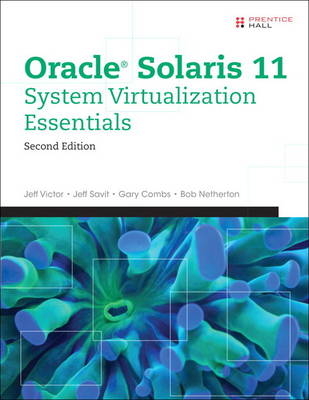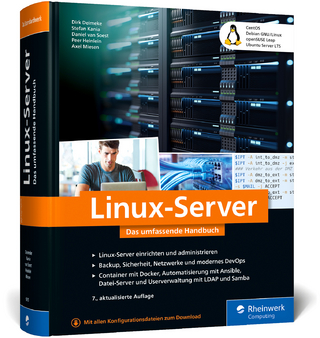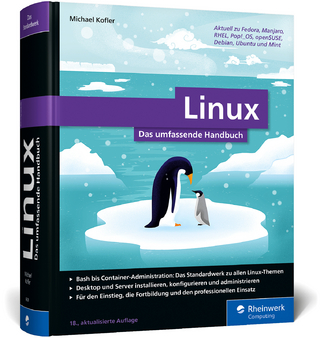
Oracle Solaris 11 System Virtualization Essentials
Pearson (Verlag)
978-0-13-431087-9 (ISBN)
- Titel ist leider vergriffen;
keine Neuauflage - Artikel merken
Oracle® Solaris 11 System Virtualization Essentials, Second Edition, has been fully updated for Oracle 11 and is a complete, practical, and up-to-date guide to selecting, implementing, and applying today’s Oracle virtualization technologies to real-world business problems.
Four Oracle experts thoroughly cover current Oracle Solaris virtualization options. They help you understand key use cases, including consolidation, asynchronous workloads, software development, testing/staging, workload mobility, legacy OS support, provisioning, scalability, fine-grained OS changes, and security. They also compare and address each leading approach to virtualization: OS virtualization, hypervisor-based virtual machines, and hardware partitioning.
The authors illuminate the use of virtualization with many Oracle software applications and engineered systems, including SuperCluster, Secure Enterprise Cloud Infrastructure, Exalytics, Oracle Database, and security hardening scenarios.
Bringing together case study examples and in-the-trenches experience, this guide explains how to
Leverage Oracle Solaris Zones to improve security, deployment, resource usage, and management
Use Logical Domains to deploy different versions of Oracle Solaris on SPARC systems
Maximize workload isolation on SPARC systems with Physical Domains
Use Oracle Solaris Zones to optimize workload efficiency and scalability
Improve data center flexibility with live migration
Develop and test software in heterogeneous environments with Oracle VM Virtual Box
Mix virtualization technologies to maximize workload density
Migrate Solaris 10 workloads to new hardware via Solaris Zones
Register your product at informit.com/register for convenient access to downloads, updates, and corrections as they become available.
Jeff Victor is a Principal Sales Engineer at Oracle Corporation. Prior to joining Oracle, Jeff was a Principal Engineer at Sun Microsystems. He leverages his expertise in computer virtualization, operating systems, and network architecture to help organizations run more efficiently. He is a regular author, contributor, and speaker at corporate and industry events. His blog can be found at http://blogs.sun.com/JeffV. Jeff received a bachelor of science degree in computer science from Rensselaer Polytechnic Institute. In his spare time, he travels with his family, leads an automated wildlife photography project, and investigates STEM topics with his daughter. Jeff lives in New York with his wife and daughter. Jeff Savit has more than 25 years of experience in operating systems, virtualization, and performance on multiple platforms, and is a Principal Sales Consultant at Oracle Corporation specializing in these areas. He was previously a Principal Field Technologist at Sun Microsystems with a similar focus. Before joining Sun, Jeff was a vice president at Merrill Lynch, where he had roles in development, systems management, market data, and web applications. He also managed a department responsible for the firm’s virtual machine systems, wrote market data portions of Merrill Lynch's Internet trading applications, and created one of the Internet’s first stock quote websites. Jeff is the author of the Sun Blueprint Energy Efficiency Strategies: Sun Server Virtualization Technology, and the virtualization chapter of the Datacenter Reference Guide Blueprint. Jeff has written or coauthored several books, including Enterprise Java, VM and CMS: Performance and Fine-Tuning, and VM/CMS Concepts and Facilities, and his work has been published in SIGPLAN Notices, a journal of the Association of Computing Machinery. He has a master’s degree in computer science from Cornell University. Gary Combs is a Sales Performance Designer at Oracle Corporation. He specializes in mid-range and high-end SPARC servers, which include the popular M-Series. Gary also covers virtualization technologies that are implemented on these platforms: Dynamic Domains, Logical Domains, and Oracle Solaris Zones. Prior to joining Oracle, Gary was with Sun Microsystems. He has more than 15 years of direct sales support experience as a systems engineer. For the last 10 years, Gary has held marketing positions in product management, product definition, and technical marketing. Bob Netherton is a Master Principal Sales Consultant at Oracle Corporation, specializing in Oracle Solaris, virtualization, open-source software, and engineered systems. Prior to joining Oracle, Bob was a Principal Field Technologist for Sun Microsystems, and was one of the architects and content developers of the Solaris Boot Camp and Deep Dive seminar series. In addition, he has developed several best practices guides for Solaris as well as an advanced Solaris training curriculum. Bob received a bachelor of science degree in applied mathematics from the University of Missouri, and he is a regular blogger on Solaris, virtualization, and open-source technologies.
Foreword to the First Edition xiii
Preface xvii
Acknowledgments xxi
About the Authors xxiii
Chapter 1: Introduction to Virtualization 1
1.1 Definitions and Motivations 1
1.2 System Virtualization Models 10
1.3 Summary 30
Chapter 2: Use Cases and Requirements 31
2.1 Introduction 31
2.2 General Workload Consolidation 32
2.3 Asynchronous Workloads 40
2.4 Software Development and Other Bursty Workloads 41
2.5 Testing and Staging 42
2.6 Simplifying Workload Mobility 43
2.7 Maintaining a Legacy Operating System on New Hardware 46
2.8 Flexible, Rapid Provisioning 47
2.9 Relieving Scalability Constraints 48
2.10 Fine-Grained Operating System Modification 49
2.11 Configurable Security Characteristics 49
2.12 Summary 50
Chapter 3: Oracle Solaris Zones 51
3.1 Introduction 52
3.2 What’s New in Oracle Solaris 11 Zones 53
3.3 Feature Overview 54
3.4 Feature Details 67
3.5 Oracle Solaris Kernel Zones 114
3.6 Solaris 10 Zones 121
3.7 Strengths of Oracle Solaris Zones 125
3.8 Summary 126
Chapter 4: Oracle VM Server for SPARC 131
4.1 Oracle VM Server for SPARC Features 131
4.2 CPUs in Oracle VM Server for SPARC 132
4.3 Features and Implementation 134
4.4 Installing Oracle VM Server for SPARC and Building a Guest Domain 149
4.5 Oracle VM Server for SPARC and Solaris Zones 168
4.6 Summary 169
Chapter 5: Physical Domains 171
5.1 Introduction 171
5.2 SPARC M6: An Introduction 172
5.3 SPARC M7: An Introduction 174
5.4 Virtualization Technologies 178
5.5 Fault Isolation 189
5.6 Oracle Enterprise Manager Ops Center 190
5.7 Summary 191
Chapter 6: Oracle VM VirtualBox 193
6.1 How Oracle VM VirtualBox Works 195
6.2 Oracle VM VirtualBox Guest Platform 198
6.3 Oracle Solaris as an Oracle VM VirtualBox Host 210
6.4 Oracle Solaris as an Oracle VM VirtualBox Guest 215
6.5 Creating and Managing Oracle VM VirtualBox Guests 216
6.6 Summary 247
Chapter 7: Automating Virtualization 249
7.1 Oracle Enterprise Manager Ops Center 249
7.2 OpenStack 256
7.3 Summary 271
Chapter 8: Choosing a Virtualization Technology 273
8.1 Review of Strengths and Limitations 273
8.2 Choosing the Technology 282
8.3 Summary 287
Chapter 9: Applications of Oracle Virtualization 289
9.1 Database Zones 289
9.2 Virtualization with Engineered Systems and Oracle SuperCluster 295
9.3 Virtualization with Secure Enterprise Cloud Infrastructure 301
9.4 Virtualization in Oracle Exalytics 308
9.5 Consolidating with Oracle Solaris Zones 309
9.6 Security Hardening with Oracle Solaris Zones 315
9.7 Customer Deployment 1 323
9.8 Customer Deployment 2 324
9.9 Customer Deployment 3 325
9.10 Summary 326
Appendix: History of Virtualization and Architectural Evolution 327
Index 345
| Erscheint lt. Verlag | 1.3.2017 |
|---|---|
| Sprache | englisch |
| Maße | 180 x 230 mm |
| Gewicht | 647 g |
| Themenwelt | Informatik ► Betriebssysteme / Server ► Unix / Linux |
| Informatik ► Betriebssysteme / Server ► Virtualisierung | |
| Informatik ► Datenbanken ► Oracle | |
| ISBN-10 | 0-13-431087-X / 013431087X |
| ISBN-13 | 978-0-13-431087-9 / 9780134310879 |
| Zustand | Neuware |
| Haben Sie eine Frage zum Produkt? |
aus dem Bereich


